the art of ruddell

Ruddell Art Gallery 2: Computer generated imagery using raytracing algorithms applied to 3D models. Some early Alias V3.0.1 images but most are generated with CDI's DesignConcept3D V6.10 Now working on new Alias V11.0.1 images.
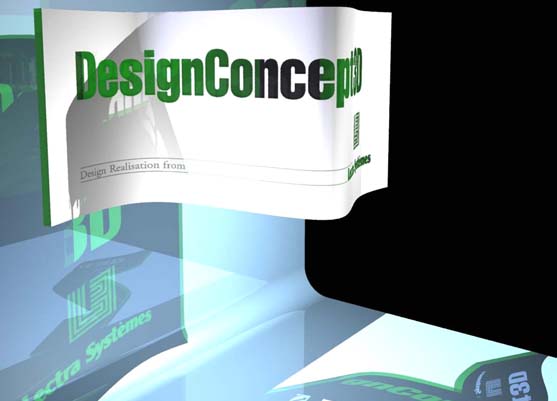 my homage to the DesignConcept3D logo, after Lectra Systemes bought the company. I love the soft turquoise and blue shades!!
my homage to the DesignConcept3D logo, after Lectra Systemes bought the company. I love the soft turquoise and blue shades!! ok . . so what is raytracing? Having built a 3D computer model you can apply colours and textures to the 3D surfaces, then create lightsources and "raytrace" the scene. The software will calculate shadows, reflections, transparency and refraction!!
ok . . so what is raytracing? Having built a 3D computer model you can apply colours and textures to the 3D surfaces, then create lightsources and "raytrace" the scene. The software will calculate shadows, reflections, transparency and refraction!! one of the rendering tutorials from Alias AutoStudio Version 11.0.1 which I am re-learning: a plain cylinder with a shader procedure called "ramp" that creates a wire mesh with transparency. Amazing!! some nice reflections and shadows going on here!!
one of the rendering tutorials from Alias AutoStudio Version 11.0.1 which I am re-learning: a plain cylinder with a shader procedure called "ramp" that creates a wire mesh with transparency. Amazing!! some nice reflections and shadows going on here!!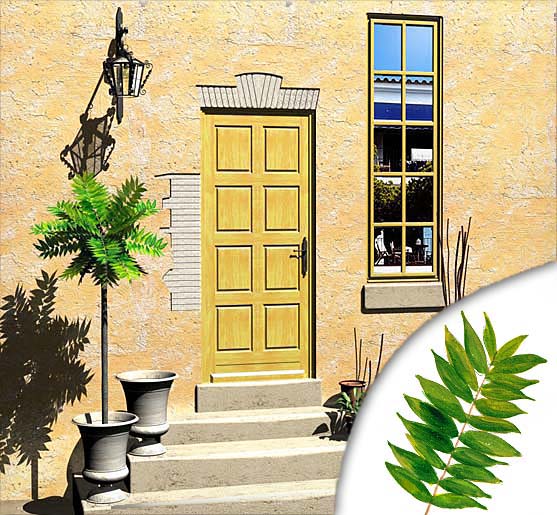 lighting is a compelling feature in Alias Studio: my French house with just a single light representing sunlight (and shade) . . Texture mapping is based on scanned photos for stone and wood texture, but hand painted leaves (inset) for the tree!!
lighting is a compelling feature in Alias Studio: my French house with just a single light representing sunlight (and shade) . . Texture mapping is based on scanned photos for stone and wood texture, but hand painted leaves (inset) for the tree!! for night-time the sunlight is turned down to a pale moonlight and the wall light and spotlights are switched on. The outside spotlights are specified with incandescence and glow . .
for night-time the sunlight is turned down to a pale moonlight and the wall light and spotlights are switched on. The outside spotlights are specified with incandescence and glow . . 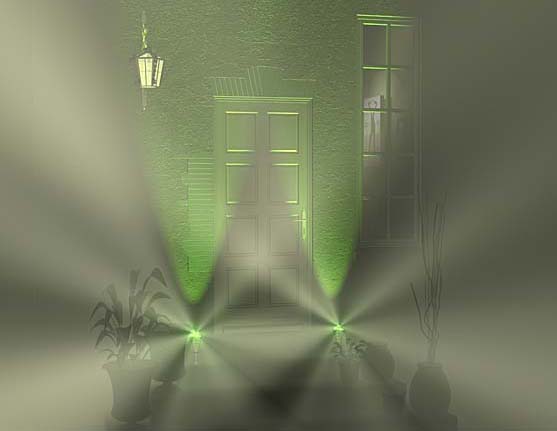 I have been wanting to try out the Alias fog routines for some years . . . Brings back good memories of demonstrating Alias Studio V3.0.1 in the 90s!!
I have been wanting to try out the Alias fog routines for some years . . . Brings back good memories of demonstrating Alias Studio V3.0.1 in the 90s!! The coffe table. Wonderful glass visualisation tools where you control the glass colour, the transparency and the refractivity.
The coffe table. Wonderful glass visualisation tools where you control the glass colour, the transparency and the refractivity.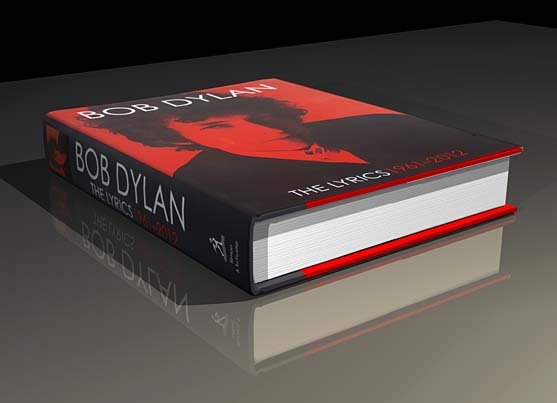 UV texture mapping (to use DesignConcept3D's terminology) - not a bad result. Books: buy them, read them, model them!!
UV texture mapping (to use DesignConcept3D's terminology) - not a bad result. Books: buy them, read them, model them!!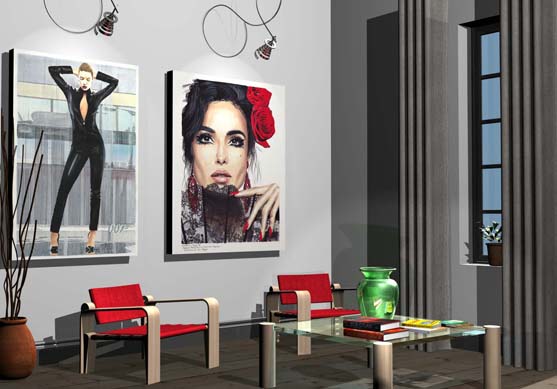 The French house interior: two wall spot lights, a main room light and sunlight outside coming through the window . .
The French house interior: two wall spot lights, a main room light and sunlight outside coming through the window . . 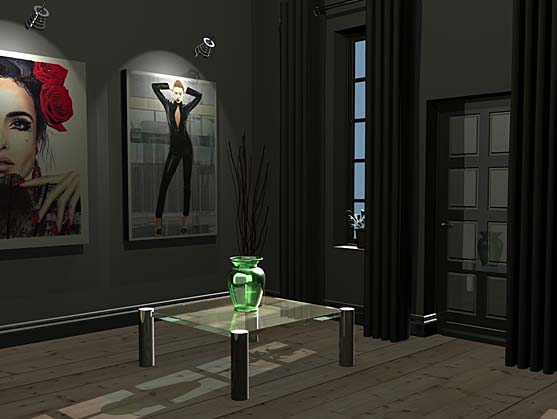 once the model is built you can experiment with different lighting. Editing the SDL file is a much quicker way of doing this than rendering within the software - it also allows you to render across multiple machines.
once the model is built you can experiment with different lighting. Editing the SDL file is a much quicker way of doing this than rendering within the software - it also allows you to render across multiple machines.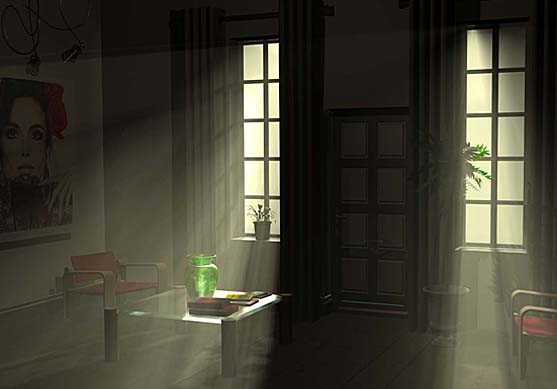 Architectural radiosity, Alias style, using two spotlights texture mapped with solid fractals and linear fog. The interior light is turned very low and has no shadows. A wonderful effect!!
Architectural radiosity, Alias style, using two spotlights texture mapped with solid fractals and linear fog. The interior light is turned very low and has no shadows. A wonderful effect!! getting up and running with the Alias V11.0.1 free form surface modelling. Excellent highlight evaluation tools and trimming tools take the stress out of building up a model from multiple surface patches.
getting up and running with the Alias V11.0.1 free form surface modelling. Excellent highlight evaluation tools and trimming tools take the stress out of building up a model from multiple surface patches.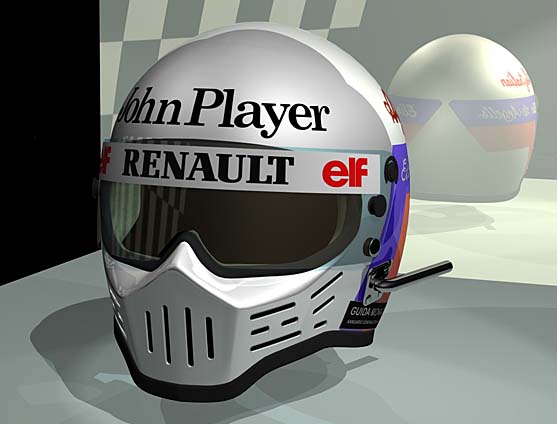 implied tangency across the model centre line, and a symmetry tool mean that you only have to model one half of a symmetrical model. For the ventilation slots here just one curve on surface is needed - the software then trims out the slot, adds a fillet and a flange: clever stuff!
implied tangency across the model centre line, and a symmetry tool mean that you only have to model one half of a symmetrical model. For the ventilation slots here just one curve on surface is needed - the software then trims out the slot, adds a fillet and a flange: clever stuff! back with CDI's DesignConcept3D: the ruddell retro car based on the MG Magnette & the Mercury Cougar . . this image shows off the power of environment mapping very well,
where the background, which is only a photograph, is mapped onto car body surfaces!
back with CDI's DesignConcept3D: the ruddell retro car based on the MG Magnette & the Mercury Cougar . . this image shows off the power of environment mapping very well,
where the background, which is only a photograph, is mapped onto car body surfaces! the French house, the ruddell sports car and the admirer . . .
the French house, the ruddell sports car and the admirer . . . Designed by George Gilbert-Scott in 1844, Westwood Church is a Grade 2 listed building so schemes for a revamped entrance had to go through quite a journey of planning permission.
Designed by George Gilbert-Scott in 1844, Westwood Church is a Grade 2 listed building so schemes for a revamped entrance had to go through quite a journey of planning permission.
 the full height glass doors (previous image) can't be achieved using the required "heritage" aluminium so an updated visualisation is done to represent the latest design condition.
the full height glass doors (previous image) can't be achieved using the required "heritage" aluminium so an updated visualisation is done to represent the latest design condition.
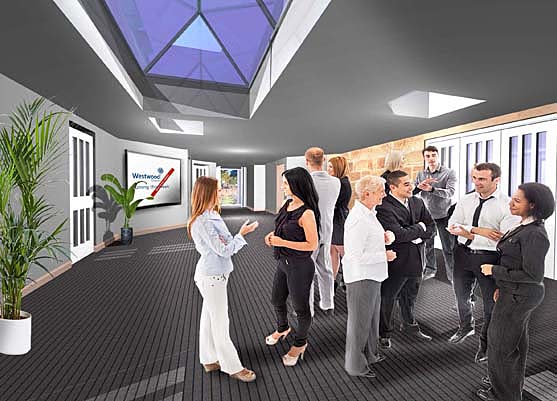 a large roof atrium and revised ceiling bring a big increase in daylight to the redecorated foyer. The original 1844 church wall remains to create a nice counterpoint with the modernised meeting area.
a large roof atrium and revised ceiling bring a big increase in daylight to the redecorated foyer. The original 1844 church wall remains to create a nice counterpoint with the modernised meeting area.
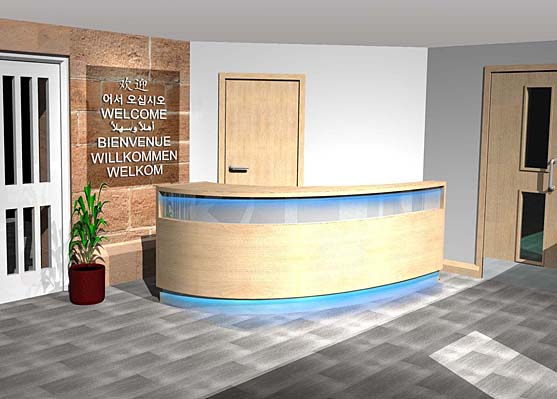 design for a split level welcome desk, plus a multi-lingual welcome sign . . . this visualisation also shows the proposed floor covering and door finishes.
design for a split level welcome desk, plus a multi-lingual welcome sign . . . this visualisation also shows the proposed floor covering and door finishes.
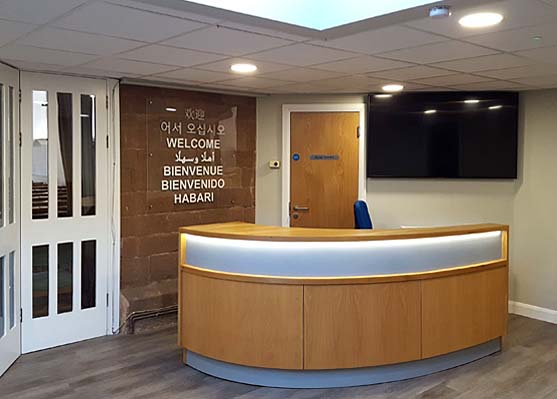 finished desk and welcome sign . . . I am happy that it looks pretty much as visualised!!
finished desk and welcome sign . . . I am happy that it looks pretty much as visualised!!
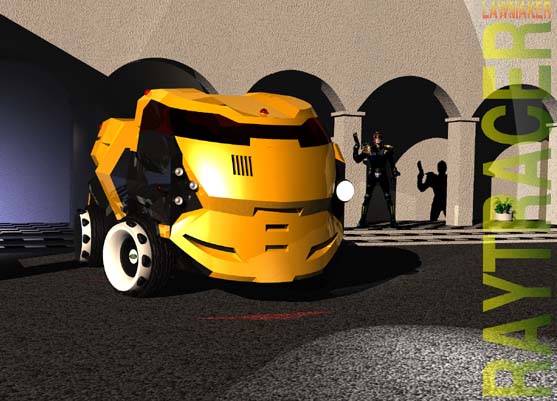 the Judge Dredd period . . . Land Rover supplied the CAD model minus wheels; I added Sylvester Stallone and the rest of the environment.
the Judge Dredd period . . . Land Rover supplied the CAD model minus wheels; I added Sylvester Stallone and the rest of the environment.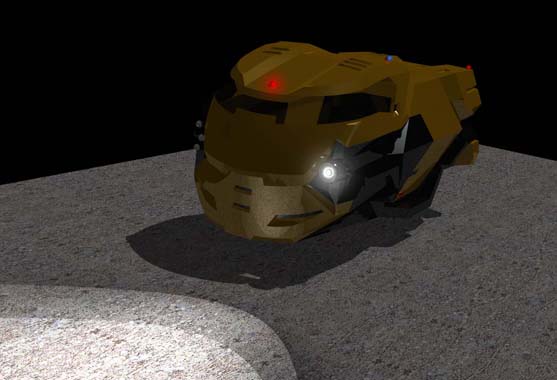 the Judge Dredd vehicle . . in hover and stealth mode . .
the Judge Dredd vehicle . . in hover and stealth mode . .  during the design of the Rolls Royce Silver Seraph, and before deciding on a rectractable Spirit of Ecstasy, there was an idea to recess the emblem into a compartment at the top of the grill . . .
during the design of the Rolls Royce Silver Seraph, and before deciding on a rectractable Spirit of Ecstasy, there was an idea to recess the emblem into a compartment at the top of the grill . . .
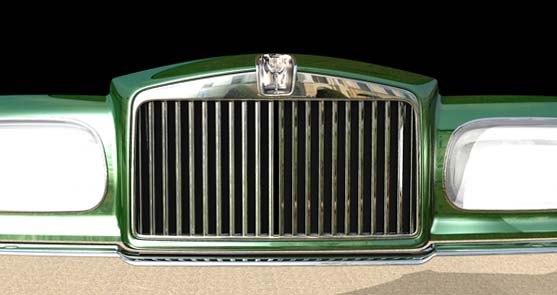 I produced a visualisation of this for Rolls Royce, as the radiator was already on CAD. Graham Hull said "of course we don't expect you
to model the statuette itself" . . haha . . . no further encouragement needed!
I produced a visualisation of this for Rolls Royce, as the radiator was already on CAD. Graham Hull said "of course we don't expect you
to model the statuette itself" . . haha . . . no further encouragement needed!
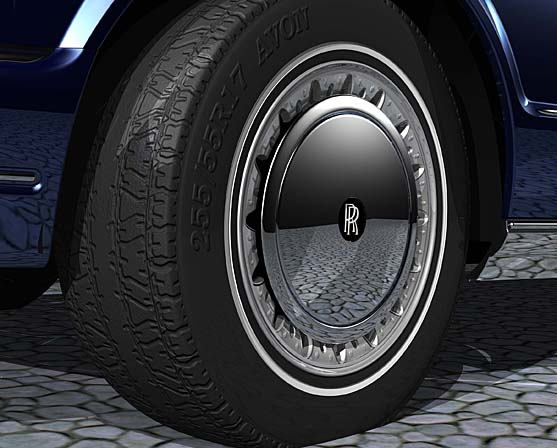 visualisation of an alternative road wheel design for the Silver Seraph: this showcases texture mapping and bump mapping quite nicely, as well as surface finish and reflections.
visualisation of an alternative road wheel design for the Silver Seraph: this showcases texture mapping and bump mapping quite nicely, as well as surface finish and reflections.
 we worked on the master CAD model to produce a 20" longer limousine version of the Silver Seraph - this is what it would have looked like outside the Crewe reception area . . .
we worked on the master CAD model to produce a 20" longer limousine version of the Silver Seraph - this is what it would have looked like outside the Crewe reception area . . .
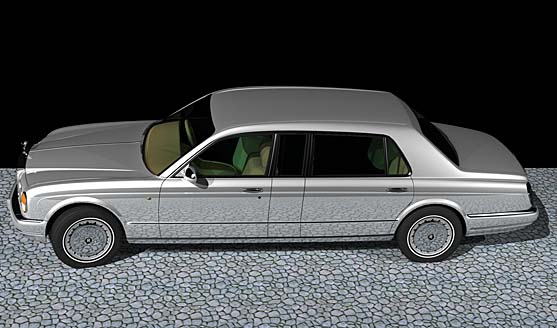 alas it was not to be:- Production was dis-continued after only 4 years, and 1570 cars, when the rights to build Rolls Royce cars was passed from Volkswagen to BMW in 2002
alas it was not to be:- Production was dis-continued after only 4 years, and 1570 cars, when the rights to build Rolls Royce cars was passed from Volkswagen to BMW in 2002
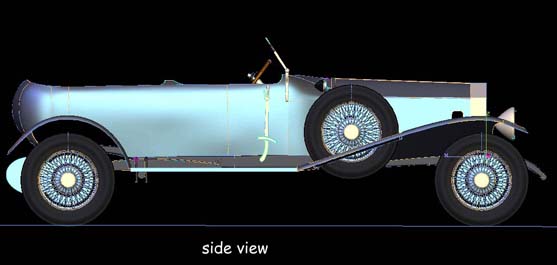 re-design of the front and rear wings for a 1921 Rolls Royce Silver Ghost . .
re-design of the front and rear wings for a 1921 Rolls Royce Silver Ghost . .
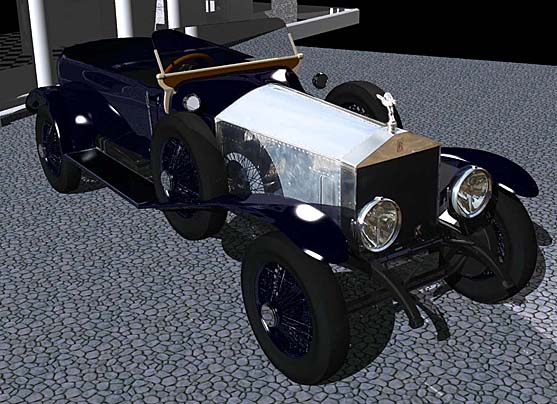 this raytracing was shown to the customer to sign off the wing design, and the colour changes
this raytracing was shown to the customer to sign off the wing design, and the colour changes
 finished vehicle looking good with my "Jaguar-esque" wing designs!! This car took part in the Spirit of Ecstasy Centenary, joining more than 100 cars in a celebratory drive around London on February 6th 2011
finished vehicle looking good with my "Jaguar-esque" wing designs!! This car took part in the Spirit of Ecstasy Centenary, joining more than 100 cars in a celebratory drive around London on February 6th 2011
 The VBE short chassis Bernato Bentley project . . the main task of the design at this stage was to resolve the body height and the rear overhang to get a nice proportion, not an easy task as we were working with a 12½" shorter wheelbase than the 1931 Gurney Nutting original.
The VBE short chassis Bernato Bentley project . . the main task of the design at this stage was to resolve the body height and the rear overhang to get a nice proportion, not an easy task as we were working with a 12½" shorter wheelbase than the 1931 Gurney Nutting original. 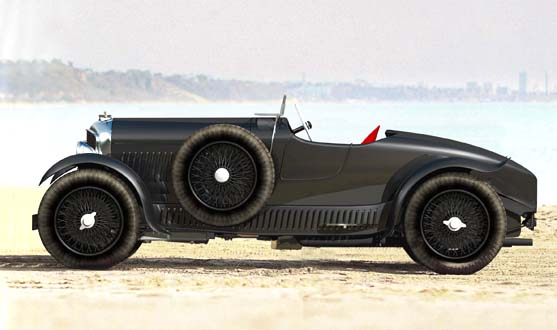 project further along: assessing the depth of the side valances and slanted louvres, as well as seeing what the car would look like painted grey. It also shows a lowered ride height . . a quick job on the computer but a lot of work for the huge leaf springs!!
project further along: assessing the depth of the side valances and slanted louvres, as well as seeing what the car would look like painted grey. It also shows a lowered ride height . . a quick job on the computer but a lot of work for the huge leaf springs!! rendering of final design, black is now the favoured colour. For the full story and production details see the Re-Engineering gallery. Suffice to say . . .
rendering of final design, black is now the favoured colour. For the full story and production details see the Re-Engineering gallery. Suffice to say . . . that when the finished design matches the concept so closely it is a testimony to DesignConcept3D software, the outstanding work done by VBE in building the car, and also to Randal Stewart, Richard Davey, Iain Beck and Chris Beaumont for their artistry in constructing the body.
that when the finished design matches the concept so closely it is a testimony to DesignConcept3D software, the outstanding work done by VBE in building the car, and also to Randal Stewart, Richard Davey, Iain Beck and Chris Beaumont for their artistry in constructing the body. messing about with a Lotus 49 model and front wheel cutaway for my limited edition print . . . Colin Chapman, Maurice Phillippe and Keith Duckworth definitely hit the sweet spot when they penned this F1 car in 1967
messing about with a Lotus 49 model and front wheel cutaway for my limited edition print . . . Colin Chapman, Maurice Phillippe and Keith Duckworth definitely hit the sweet spot when they penned this F1 car in 1967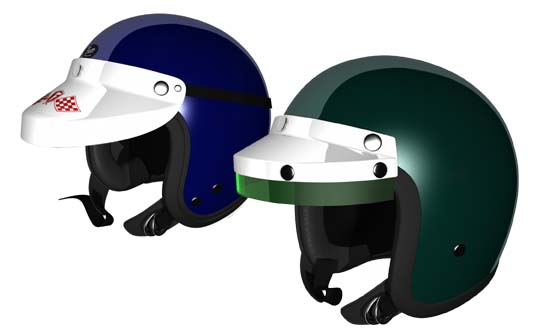 period crash helmet models for my Lotus 49 40th Anniversary limited edition print . . .
Jim Clark's 1967 helmet and Jochen Rindt's 1970 helmet.
period crash helmet models for my Lotus 49 40th Anniversary limited edition print . . .
Jim Clark's 1967 helmet and Jochen Rindt's 1970 helmet.
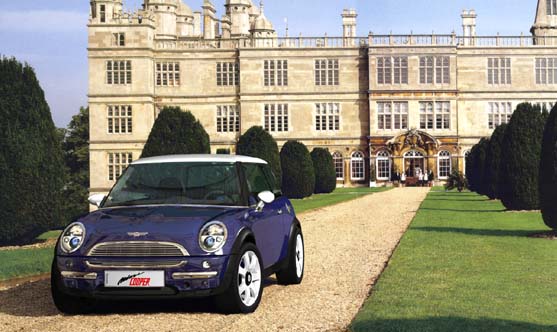 visualisation done for Rover in the mid '90s on something called "the new Mini" . . .
visualisation done for Rover in the mid '90s on something called "the new Mini" . . .
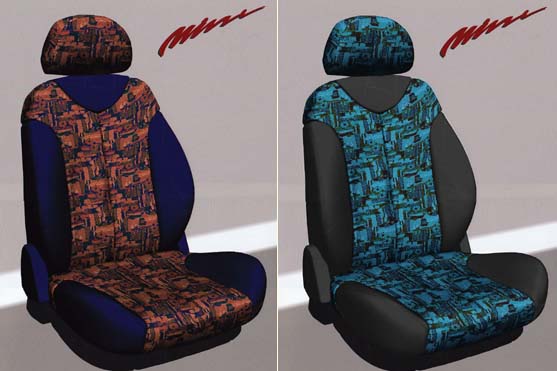 these images, printed out poster size, created a stir with Rover's Colour and Trim review team . . they were confused because they thought they were photographs of prototype seats . . which they hadn't yet authorised the budget to build!!
these images, printed out poster size, created a stir with Rover's Colour and Trim review team . . they were confused because they thought they were photographs of prototype seats . . which they hadn't yet authorised the budget to build!!
 a really nice CAD model from Omni Design, one of my favourite renders (DesignConcept3D) because the bodywork looks so metallic.
The reflections on the body surface in this image are reflected from a real modelled environment.
a really nice CAD model from Omni Design, one of my favourite renders (DesignConcept3D) because the bodywork looks so metallic.
The reflections on the body surface in this image are reflected from a real modelled environment.
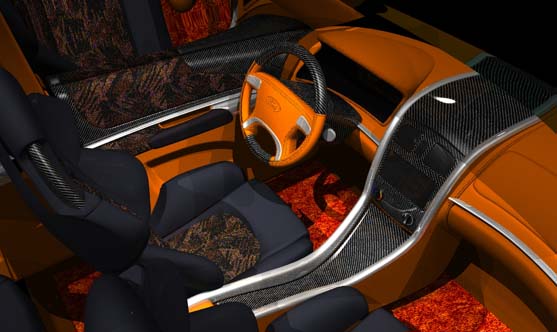 Ford Tierra interior model done for Hsin Chong in Taiwan
Ford Tierra interior model done for Hsin Chong in Taiwan
 close up of the steering wheel that shows off the texture mapping nicely: kevlar, leather grain and stitching
close up of the steering wheel that shows off the texture mapping nicely: kevlar, leather grain and stitching
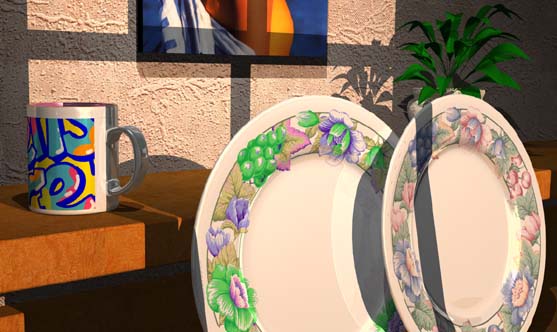 in our ceramic period, using U4ia for the colorways visualisations on the plates
in our ceramic period, using U4ia for the colorways visualisations on the plates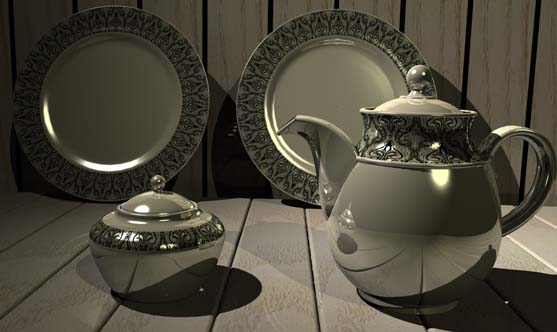 one of the first ruddell renderings the CDI people had seen . . this raised eyebrows when we unveiled it . . so realistic and sharp! Modelled by Canewdon, the original CDI distributor in the UK back in the 80s.
one of the first ruddell renderings the CDI people had seen . . this raised eyebrows when we unveiled it . . so realistic and sharp! Modelled by Canewdon, the original CDI distributor in the UK back in the 80s.
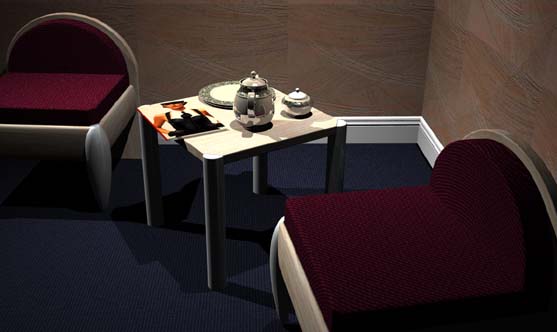 furniture design house in Munster . . we designed and modelled the chairs in the morning, added a table, the Canewdon tea set and some other stuff and rendered it over lunch . .
furniture design house in Munster . . we designed and modelled the chairs in the morning, added a table, the Canewdon tea set and some other stuff and rendered it over lunch . .
 office furniture company in the Black Forest: in the morning we digitised the seat foams, modelled them and trimmed them virtually, added the seat frame and then rendered the finished model over lunch!
office furniture company in the Black Forest: in the morning we digitised the seat foams, modelled them and trimmed them virtually, added the seat frame and then rendered the finished model over lunch!
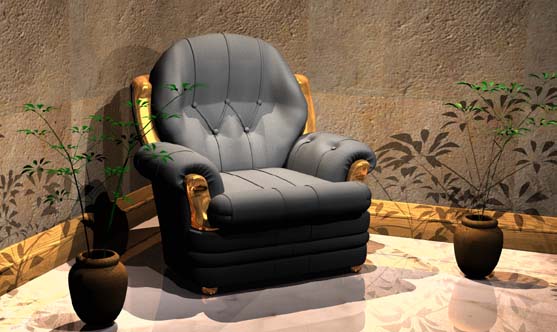 continuing our furniture period, for Bouyant, with ruddell umbrella plants that never need watering
continuing our furniture period, for Bouyant, with ruddell umbrella plants that never need watering
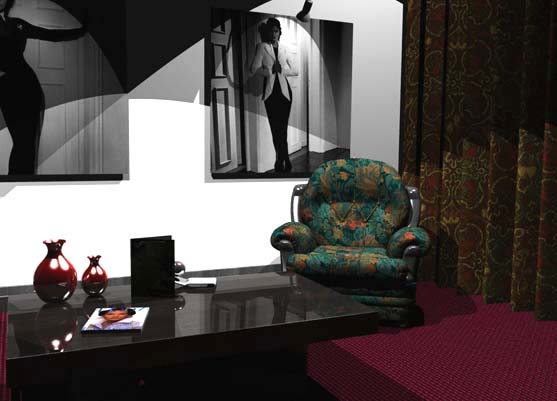 armchair and room model, which was actually the demo piece we presented to uphoslstery companies, modelling various objects in the room live, then showing the finished render
armchair and room model, which was actually the demo piece we presented to uphoslstery companies, modelling various objects in the room live, then showing the finished render
 in our Bra Engineering period . . I always seemed to be out when they wanted the models digitising . . I remember that this image was completed around 1.30 in the morning whilst Genower and I prepared visuals for an apparel show that started in Koln the next day!
in our Bra Engineering period . . I always seemed to be out when they wanted the models digitising . . I remember that this image was completed around 1.30 in the morning whilst Genower and I prepared visuals for an apparel show that started in Koln the next day!
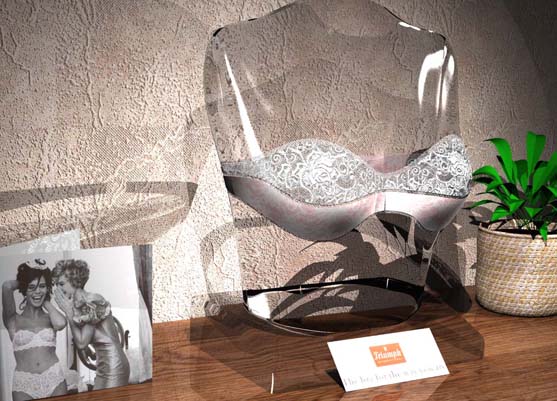 following the Koln trade show, this strapless bra featured in our demos to Triumph in Germany
following the Koln trade show, this strapless bra featured in our demos to Triumph in Germany
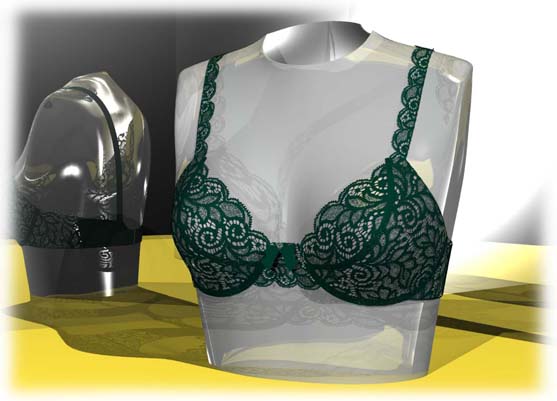 the Textil Forschungs Institut in Greiz designed this bra with the software and then produced it as an actual lingerie product.
the Textil Forschungs Institut in Greiz designed this bra with the software and then produced it as an actual lingerie product.
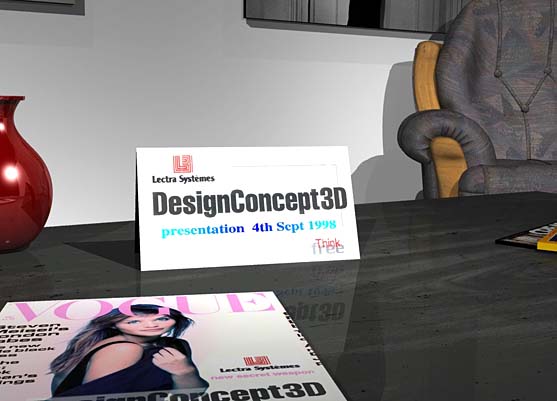 Title Slide of a 3D presentation I did for the Lectra Users Group at headquarters in Cestas, in September 1998
Title Slide of a 3D presentation I did for the Lectra Users Group at headquarters in Cestas, in September 1998
 showing how a logo can be texture mapped, or embossed into a surface
showing how a logo can be texture mapped, or embossed into a surface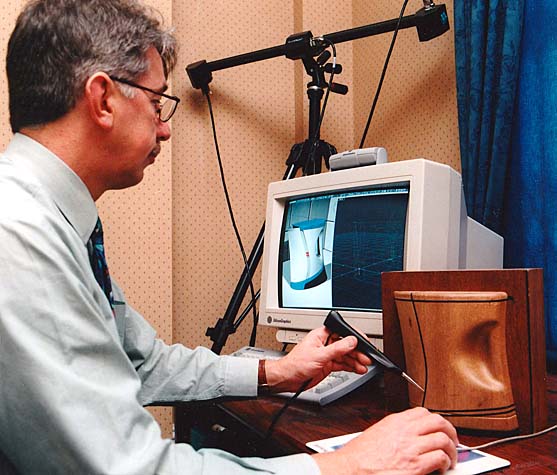 this was the ruddell kettle demo, where we made a wood model of the shape to prove out the ergonomics of the handle, then digitised this . .
this was the ruddell kettle demo, where we made a wood model of the shape to prove out the ergonomics of the handle, then digitised this . . and designed the rest of the product on screen.
and designed the rest of the product on screen.
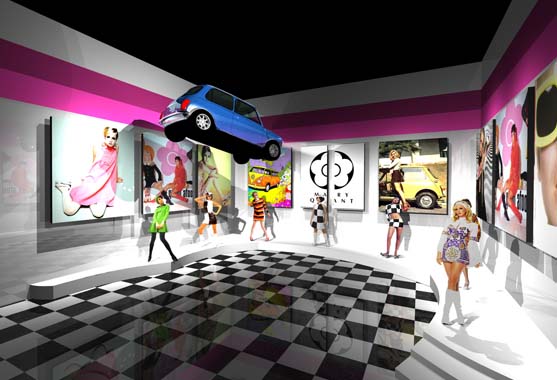 visualisation of the Mary Quant commemorative pavilion with life size 60s figures and a real mini used as the lighting rig . . .
visualisation of the Mary Quant commemorative pavilion with life size 60s figures and a real mini used as the lighting rig . . .
 visual of a garden design that was going to be constructed as part of a landscape competition. . .
visual of a garden design that was going to be constructed as part of a landscape competition. . .
 the original ruddell Alias 3.0.1 demo using a few curves and 5 minutes of modelling . . .
the original ruddell Alias 3.0.1 demo using a few curves and 5 minutes of modelling . . .
 the one hour ruddell demo using Alias and some modelling I prepared earlier . . .
the one hour ruddell demo using Alias and some modelling I prepared earlier . . .
 the ECS Christmas card - the falling snow was a transparency texture map but the snow on the ground was an Alias procedure, using fractals. Very clever!
the ECS Christmas card - the falling snow was a transparency texture map but the snow on the ground was an Alias procedure, using fractals. Very clever!
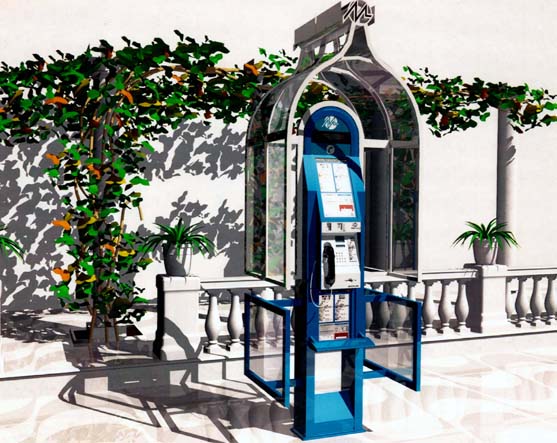 a somewhat crazy model I built of a Mercury phone box, during the ECS/Mercury Communications collaboration leading up to Telecom 91
a somewhat crazy model I built of a Mercury phone box, during the ECS/Mercury Communications collaboration leading up to Telecom 91
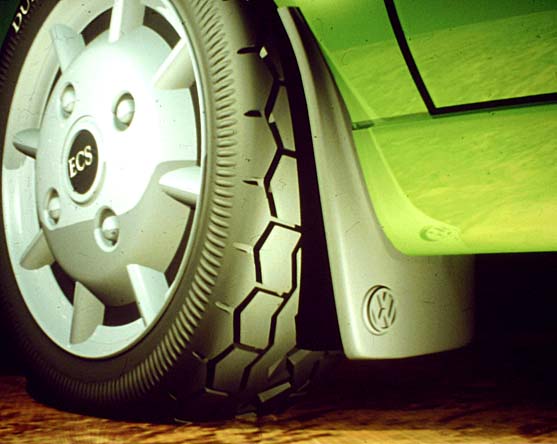 benchmark modelling for Dunlop . . I remember this being done in the actual Fort Dunlop building which Dunlop were still using in the 90s
benchmark modelling for Dunlop . . I remember this being done in the actual Fort Dunlop building which Dunlop were still using in the 90s

Back where it started: At Whitley in the Jaguar Design Studio in the mid 80s, using the Computervision CADDS4X display image program . . my first experience of visualisation. Finished images were fairly low res, but did calculate shadows. The results sparked my interest .
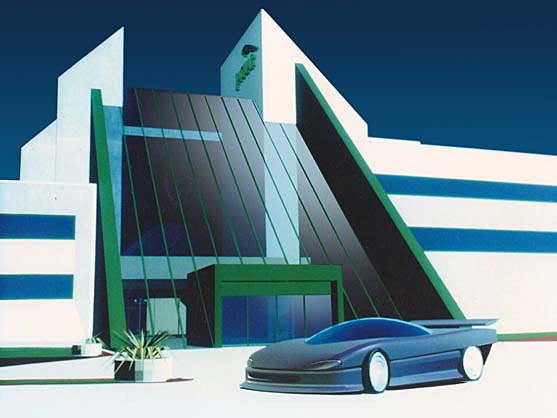
A very basic sports car concept, and the new Jaguar Engineering Centre at Whitley, all modelled on Computervision CADDS4X in 1988 . . but rendered within Wavefront on a Silicon Graphics workstation at Wavefront's headquarters in Santa Barbara, California.
